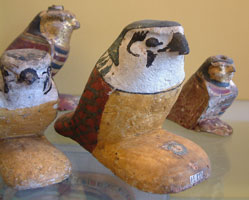
Sokar (also known as Seker, and in Greek, Sokaris or Socharis) was the Memphite god of the dead, but he was also the patron of the workers who built the necropolis, the craftsmen who made tomb artefacts, and of those who made ritual objects and substances used in mummification.
The meaning of his name is unclear. It may be derived from the term “skr” (meaning “cleaning the mouth”) mentioned in the Coffin Texts and in writings relating to the “Opening of the Mouth” ceremony (one of the funerary rituals). However, others suggest that it relates to the phrase “sy-k-ri” (“hurry to me”) which was the cry for help uttered by Osiris to Isis, while some suggest it means “the adorned one”.

Sokar was known by the epithet “he of Rosetau”. This refers to the area around the Giza pyramids, but also related more generally to any necropolis and to the entrance to the underworld. He is also known as the “lord of the mysterious region” (the underworld) and the “great god with his two wings opened” – referring to his origins as a hawk deity.

Memphis was the primary cult centre of Sokar. On the 26th day of 4th month of akhet (sowing), the festival of Sokar (Choiak) was held there. Egyptians performed the rituals of hoeing the earth and driving cattle, implying that Sokar was also an agricultural deity, and a huge statue of the god was carried around on a Henu barque (a boat with a high prow shaped like a horned oryx and a funerary chest).
By the Middle Kingdom, the festival incorporated Osirian aspects of festivals in Abydos, and by the New Kingdom, the festival had expanded to Thebes, where it rivaled the great Opet Festival. It is thought that the festival celebrated the rebirth of Osiris and stressed the continuity of pharaonic power.

Sokar was initially worshiped as a totem, and then as a personified hawk or falcon. However, during the Old Kingdom he was generally depicted on a throne with the Was (power) sceptre and an Ankh (life). By the New Kingdom he was depicted as a hawk-headed mummy with a Was sceptre (representing power), a flail, and a crook. Sokar usually stands on a funerary mound (which may represent the primeval mound) and wears a sun disc, cows horns and the regal cobras (similar to the Atef-crown), although in certain situations he wears the White Crown. As a falcon deity, he is often related to Horus, and wears the double crown of Upper and Lower Egypt.
Sokar is mentioned regularly in the Pyramid Texts in his own right, but from the Middle Kingdom he was often merged with Ptah. Ptah-Sokar represented the soil and its power to create life. As Ptah was considered to be the patron of artisans, Sokar became specifically the patron of goldsmiths.

Soon after, Sokar became associated with Osiris as the composite deity, Ptah-Sokar-Osiris. This composite deity represented the three aspects of the universe: creation, stability, and death. In the New Kingdom Period, in the Book of the Dead, Sokar unites the forms of Osiris and Ptah. Ptah-Sokar became Sokar-Osiris (the nocturnal sun during the fourth and fifth hours of the Amduat). The priests of Sokar retained the same titles that the Memphite priests of Ptah had used during the Old Kingdom, but now they almost always refer to the high priests of Heliopolis.
Ptah-Sokar-Osiris is generally depicted as a mummiform hawk bearing the regalia of kingship. However, he was also pictured as a pygmy with a scarab beetle on his head (representing Kheper). It is thought that these images of Ptah-Sokar-Osiris were the source of the deity called Pataikos by Herodotus. Although Ptah-Sokar was married to Sekhmet, Sokar was sometimes linked to Nephthys.

The Amduat (“that which is in the netherworld”) describes the underworld in terms of the journey of Ra through twelve hours (or stages). Sokar inhabits hours four and five of the underworld.
During the fourth hour, Ra enters the desert of Rostau. The river becomes a dry bed littered with dangerous snakes and the path is repeatedly blocked by huge doors. Ra’s barque is transformed into a fire breathing snake and Thoth and Sokar protect the sun god as he makes his slow progress through the desert. In the fifth hour, the sun must pass over the cave of Sokar. Inside the cave, Sokar restrains the winged serpent Apep, representing chaos. The cave of Sokar is guarded by Aker lions.
These depictions have led some to speculate that Rostau was located near Gebel Gibli, close to the Great Pyramid, and that an actual Tomb of Sokar is yet to be found under the sand close to the mysterious gateway and enclosure wall known as the “Wall of the Crow”. So far, no evidence has either proved or discounted this theory.
Bibliography
- Bard, Kathryn (2008) An introduction to the Archaeology of Ancient Egypt
- Pinch, Geraldine (2002) Handbook Egyptian Mythology
- Redford, Donald B (2002) Ancient Gods Speak
- Watterson, Barbara (1996) Gods of Ancient Egypt
- Wilkinson, Richard H. (2003) The Complete Gods and Goddesses of Ancient Egypt
Copyright J Hill 2016